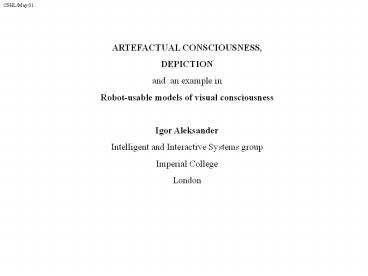ARTEFACTUAL%20CONSCIOUSNESS, PowerPoint PPT Presentation
Title: ARTEFACTUAL%20CONSCIOUSNESS,
1
ARTEFACTUAL CONSCIOUSNESS, DEPICTION and an
example in Robot-usable models of visual
consciousness Igor Aleksander Intelligent and
Interactive Systems group Imperial College London
2
- Main Points
- Inner Depiction what is it? What isnt it?
- What else? (5 what elses)
- What do you need to know to accuse an artefact
of maybe being conscious? - Why is this not GOFAI or GOFANN?
- The example not ultimate but embryonic.
- A philosophical missile shield.
3
- Inner Depiction what is it? What isnt it?
- It is the pattern of firing activity of a subset
of cells in a massive, structured cellular system
(the system also possesses non-depictive cells)
which has.. - .. (some)1 correspondence with the world
relative to the observer - . a (some)1 correspondence with the elements of
immediate sensation and this defines what the
artefact is conscious of at any time. - It is not a symbolic encoding of world events,
but as accurate as possible a model of world
events. - It is not a 2-D picture in the head .
4
Aleksander Dunmall An extention to the
hypothesis of visual conciousness. Proc R Soc
Lond B (2000) 267, 197-200 Velmans
Understanding Consciousness - Routledge 2000
Aleksander How to build a mind Weidenfeld
and Nicolson, 2000 NRM www.sonnet.co.uk/nts
5
- What else? (5 what elses)
- Necessary abstract conditions for an artefact to
be considered as potentially conscious. - 1. Perceptual Possession of a mechanism that
depicts the material world from the point of view
of the organism, using all available sensory
modalities. Note gaze-locking in primate vision. - 2. Reflexive The depiction is of an out
there world which requires action to be reached
i.e. the motor effort is part of the depiction. - 3. Imaginational Supepositional recall of
past depictions in function of the current
depiction. - 4. Active The ability to map depiction to
action conditionally on current depiction. - 5. Predictive Ability to predict changes that
result from action depictively.
6
- What do you need to know to accuse an artefact of
maybe being conscious? - Judging behaviour is not it!
- Introspection is not helpful in defining what we
are looking for. - I suggest looking for depictive ability in the
mechanism including the 5 constraints. No
depictive mechanisms, no opportunity for
consciousness.
7
- Why is this not GOFAI or GOFANN?
Depiction implies... Fine granularity within
depictive modules with each grain a state
variable of a dynamic system. (NOT GOFAI) An
evolved architecture of specialised modules to
cope with many streams of sensory input,
depictional areas and output action. (NOT
GOFAI) Knowledge coded by learning of state
trajectories in this evolved architecture in
GOFANN it is thought to be coded in weight
matrices. (Depictional systems could be achieved
with GOFANN, but this has been too weight-fixated
- our models are weightless).
8
- The example not ultimate but embryonic.
9
- The example not ultimate but embryonic.
Note... possible transfer to robots
10
(No Transcript)
11
- A philosophical missile shield.
Velmans idea of reflexive consciousness
(functional activity that has out-thereness) is
supported by depiction. Inner sensation in an
artefact cannot be distinguished from Depiction
and depiction is technologically
achievable. Even in human beings, others depict
whereas I am conscious.

